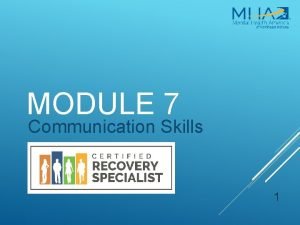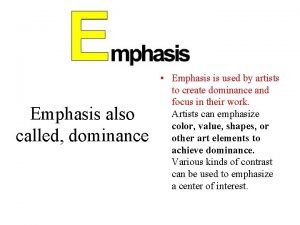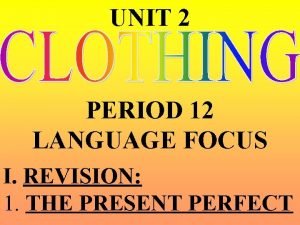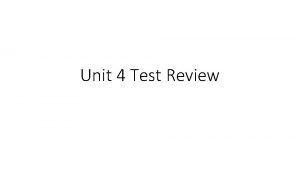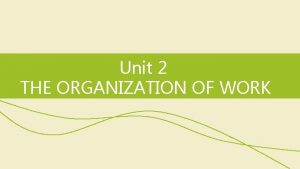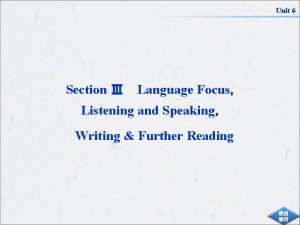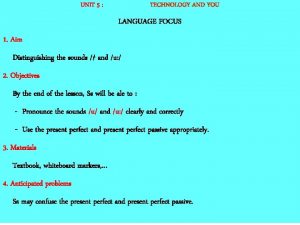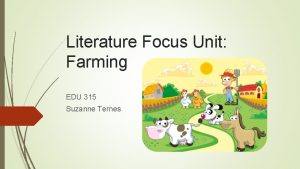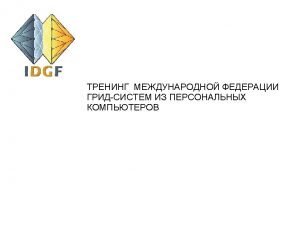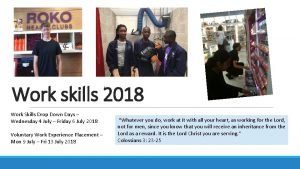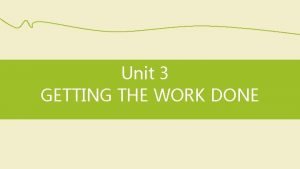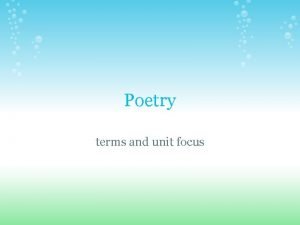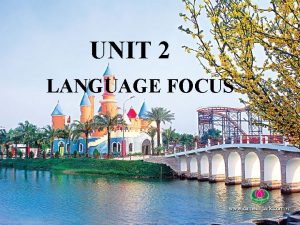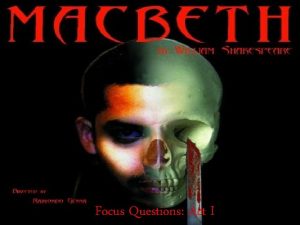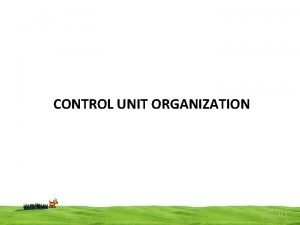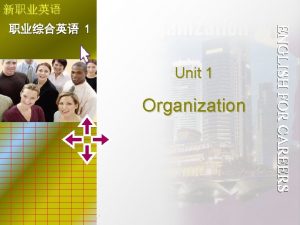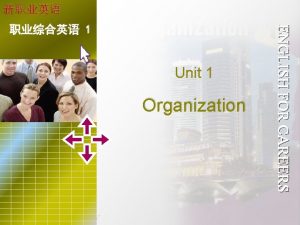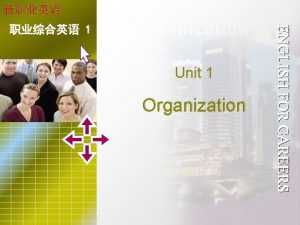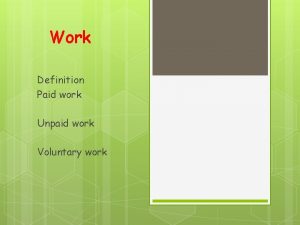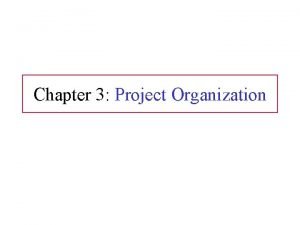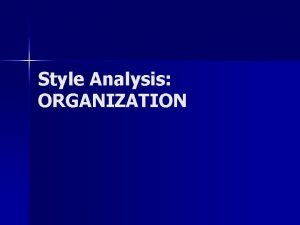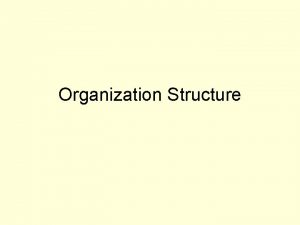Unit 2 THE ORGANIZATION OF WORK Skills focus











































- Slides: 43

Unit 2 THE ORGANIZATION OF WORK

Skills focus Reading • using research questions to focus on relevant information in a text • using topic sentences to get an overview of the text Writing • writing topic sentences • summarizing a text Vocabulary focus • English–English dictionaries: headwords definitions parts of speech phonemes stress markers countable/uncountable transitive/intransitive

2. 1 Vocabulary 2. 2 Reading 2. 3 Extending skills 2. 4 Extending skills

Vocabulary bank Using your English–English dictionary This kind of dictionary helps you actually learn English. Using headwords and parts of speech 1 Find the correct headword. These bold words in a dictionary are in alphabetical order. Look at the words on the top left and top right of the double page. Find words which come just before and after your word. 2 Find the correct meaning. If there are different meanings of the word, they appear in a numbered list. Look at all the meanings before you choose the correct one in context.

Vocabulary bank Using your English–English dictionary Using headwords and parts of speech 3 Find the correct part of speech. Sometimes the same headword appears more than once, followed by a small number. This means the word has more than one part of speech, e. g. , n and v. Work out the part of speech before you look up a word. Clues: • Nouns come after articles (a/an/the) or adjectives. • Verbs come after nouns or pronouns.

2. 1 Vocabulary A How can an English–English dictionary help you understand produce spoken and written English? The following information is useful for spoken English: lstress lpronunciation of individual phonemes – particularly when a phoneme has multiple pronunciations The following information is useful for written English: linformation about the type of word – C/U; T/I lthe spelling lexamples of the word in use to memorize lsome synonyms for lexical cohesion

2. 1 Vocabulary B Study the dictionary extract in your textbook. 1 Why are the two words (top left and top right) important? They tell you the first and last words on the pages to help you locate the word you want. 2 How many meanings does management have? Three. 3 Why does the word market appear twice in bold? Because the same word can be a noun or a verb.

2. 1 Vocabulary B Study the dictionary extract in your textbook. 4 What do we call someone who works in marketing? A marketer. 5 Where is the main stress on managerial? What about managing director? Managerial – on the third syllable; managing director – on the second syllable of director. 6 What is the pronunciation of g in each bold word in this extract? /dʒ/ (e. g. , manage); /ŋ/ (e. g. , marketing). 7 What is the pronunciation of a in each bold word in this extract? Four pronunciations: /æ/ or /a: / in stressed syllables; /i/, or /ə/ in unstressed syllables.

2. 1 Vocabulary B Study the dictionary extract in your textbook. 8 What part of speech is marketable? Adjective – able marks an adjective. 9 Are both of these correct? The management is/are responsible for the failure of the company. Both are correct, but once you have chosen to use one form, you should not use the other in the same text. 10 Can we write: A new computer model is marketing. Why (not)? Usually no – because to market is transitive, so it must have an object.

2. 1 Vocabulary C Look at the bold words in the dictionary extract in your textbook. 1 What order are they in? Alphabetical order. 2 Write the words in the box in the same order. administrator boardroom complex hierarchy initiative informal labour layer procedure resources rigid routine structure task team

2. 1 Vocabulary D Look at the top of this double page from an English– English dictionary. 1 Which word from Exercise C will appear on these pages? Routine will appear on the double page spread. 2 Think of words before and after some of the words in Exercise C.

E Look up the bold words in the box in a dictionary. 2. 1 Vocabulary 1 How many meanings can you find for each word? 2 Which words are both a noun and a verb? What kind of verbs are they? 3 What kind of noun is each one? 4 How are the words used in business management? Word Part of speech Type procedure n C task n C resources n C Main meaning in banking Main meaning in general English a set of rules for how a a set of actions necessary to do business activity should be something carried out or managed a piece of work that must be done used with human it means the department which deals with the people in an organization; used with financial it means money qualities or possessions that are to be used; often used in relation to a country (e. g. , natural resources such as coal, oil)

E Look up the bold words in the box in a dictionary. 2. 1 Vocabulary 1 How many meanings can you find for each word? 2 Which words are both a noun and a verb? What kind of verbs are they? 3 What kind of noun is each one? 4 How are the words used in business management? Word boardroom layer Part of speech Type Main meaning in banking Main meaning in general English n C the room where the a set of actions necessary to do directors of a company have something their meetings n C a level of management v T a thickness of a material (e. g. , layers of different types of rock) cut hair or arrange clothes in layers

E Look up the bold words in the box in a dictionary. 2. 1 Vocabulary 1 How many meanings can you find for each word? 2 Which words are both a noun and a verb? What kind of verbs are they? 3 What kind of noun is each one? 4 How are the words used in business management? Word structure Part of speech Type n C n U v T Main meaning in banking when used with organizational, a type of organization Main meaning in general English something that has been made or constructed how the parts of something make a when used with organizational, the concept whole (e. g. , brain structure) of structure in organizations arrange parts into a whole

E Look up the bold words in the box in a dictionary. 2. 1 Vocabulary 1 How many meanings can you find for each word? 2 Which words are both a noun and a verb? What kind of verbs are they? 3 What kind of noun is each one? 4 How are the words used in business management? Word team Part of speech Type Main meaning in banking Main meaning in general English n C a group of people who play a group of people who work together in a game (e. g. , football on a task together team) n U 1. workers considered as a group, e. g. , organized v I work labour 1. work; 2. giving birth; 3. (Labour) UK political party work

2. 1 Vocabulary F Look up the words in the box. 1 Where is the stress in each word? 2 What is the sound of the underlined letter(s) in each word? 3 Which meaning is most likely in business management? Stress Sound Part of speech Type 'hierarchy /ai/ n C/U ad'ministrator /ə/ n C ri'gid /dʒ/ adj /ʃ/ n i'nitiative /ɔ/ rou'tine /u: / n/adj in'formal /ə/ adj Main meaning in business a pyramid-shaped organizational structure. C/U a person whose job is to organize a rigid hierarchy is one where there are strict definitions of jobs and many layers of management able to be transferred from one person to another or exchanged for cash not easy or simple. A complex production process has many stages. C a regular way of working / something that always happens adj 'complex hierarchy administrator rigid initiative complex routine informal not following fixed rules

2. 1 Vocabulary G Test each other on the words from Exercises E and F. Give the dictionary definition of one of the words. Can your partner guess which word you are defining?

2. 1 Vocabulary H Describe the organizational structures in the diagrams. Structure 1 hierarchical (or pyramid) structure Structure 2 task (or matrix) structure

2. 2 Reading A What do you prefer – to work by yourself, with another person, or in a team? Why?

2. 2 Reading B Look at the pictures on this page. 1 What type of work is taking place in each picture? 2 Which pictures show team work? 3 Which pictures show skilled work? 4 Where are the workers likely to be in an organizational hierarchy?

2. 2 Reading Type of work 1. individual employees working on a production line 2. a group of people working together-medical staff during an operation B Look at the pictures on this page. 1 What type of work is taking place in each picture? 2 Which pictures show team work? 3 Which pictures show skilled work? 4 Where are the workers likely to be in an organizational hierarchy? Team work? Skilled? no no yes 3. a secretary is carrying out her boss’s instructions no 4. a potter making a pot no the secretary is skilled; bosses are usually skilled and educated yes – this worker is highly skilled and may take a long time to learn his trade Hierarchy these people are probably unskilled manual workers – usually at the bottom of the hierarchy these people are higher in a hierarchy than the worker in the picture above this is a typical hierarchical situation: the boss tells the secretary what to do he may be employed, and fairly low in the hierarchy; or he may work for himself

2. 2 Reading C You are going to read a text. What should you do before you read a text in detail? See Skills bank.

Skills bank Doing reading research Before you start reading … l Think of research questions. In other words, ask yourself: What must I find out from my research? l Look at headings, sub-headings, illustrations, etc. Look for patterns or variations in presentation, e. g. , a series of dates; words in bold or italic script. Think: What information do they give me? l Decide how to record information from your reading. Choose one or more methods of note-taking. See Unit 1 Skills bank.

2. 2 Reading D This text is about organizational structures. 1 Think of some research questions before you read. 2 Compare your questions with those in the Hadford University assignment on this page.

2. 2 Reading E Study these topic sentences from the text and answer the questions. 1 What types of organizational structure are discussed in the text? Large, traditional hierarchies; flatter hierarchies; plus other types, of which two are mentioned here: task structure and person structure.

2. 2 Reading E Study these topic sentences from the text and answer the questions. 2 Where might you find the answer to each question in the university assignment? Write 1, 2 or 3 next to the topic sentence. In the first half of the 20 th century, organizations tended to be controlled in rigid hierarchies. 1 However, there a number of problems with large, traditional hierarchies. As a result, some companies have moved towards flatter hierarchies, … 2 However, different types of company may need different types of organizations. 3 There are other possible ways in which organizations can be structured. In the ‘task’ structure, several people work together as a team, using their different skills. 3 Finally, a ‘person’ structure can be found where there is a group of people who are experts in 3 their field. Of course, in real life, organizations rarely have just one structure.

2. 2 Reading F Read the text on the opposite page and check your ideas. See Skills bank.

Skills bank Doing reading research While you are reading … l l Highlight the topic sentences. Think: Which paragraph(s) will probably give me the answer to my research questions? l l Read these paragraphs first. Make notes. After reading … l l Think: Did the text answer all my research questions? If the answer is no, look at other paragraphs to see if the information is there.

2. 3 Extending skills A Study the words in box a. They are all from the text in Lesson 2. 1 Look back at the text on page 17. Find the words which go together with the words in the box. 2 Do they make noun or verb phrases? 3 What is the meaning of each phrase? Look at the context and check with your dictionary if necessary.

2. 3 Extending skills A Study the words in box a. They are all from the text in Lesson 2. Phrase Noun or verb phrases? functional areas noun phrase parts of a business concerned with a particular function division of labour noun phrase dividing the work so that each person has one small job to do clearly defined segments noun phrase the bits of work which go to make up the whole job take responsibility verb phrase work without being told how to or what to do use their initiative verb phrase contribute or use their own ideas in their work business environment noun phrase a team approach a job description lines of management Meaning the business world outside the company noun phrase a way of working, using teams noun phrase a document about what an employee should do in his/her job an organizational structure which makes it clear who is in charge of who/what noun phrase

2. 3 Extending skills 1 2 3 B Study the words in box b. What is the base word in each case? What is the part of speech of the base word? Does the prefix/suffix change the part of speech? How does the prefix/suffix change the meaning of the base word?

2. 3 Extending skills Word B Study the words in box b. Base word Affix and meaning traditional tradition (n) al = noun ➔ adjective flatter flat (adj) er = comparative form delayered layer (n) de = negate ; ed = verb ➔ adjective disintegrate (v) dis = negate cooperation operate (v) co = together; (t)ion = verb ➔ noun professional profession (n) al = noun ➔ adjective

2. 3 Extending skills Topic sentence C Look back at the text on page 17. After each topic sentence, how does the writer continue the paragraph? Choose one or more from the following list: Followed by In the first half of the 20 th century, organizations tended to be controlled in rigid hierarchies. However, there a number of problems with large, traditional hierarchies. As a result, some companies have moved towards flatter hierarchies, … However, different types of company may need different types of organizations. defining and describing a list of points restating the topic sentence giving more information giving an example There are other possible ways in which organizations can be structured. giving an example defining and describing In the ‘task’ structure, several people work together as a team, using their different skills. defining and describing Finally, a ‘person’ structure can be found where there is a group of people who are experts in their field. defining and describing Of course, in real life, organizations rarely have just one structure. restating the topic sentence

2. 3 Extending skills See Skills bank. D Write a summary of the information in the text on page 17. Practise using the words you have learnt so far.

Skills bank Using topic sentences to summarise The topic sentences of a text normally make a good basis for a summary. Follow this procedure: l Locate the topic sentences. l Paraphrase them – in other words, rewrite them in your own words so that the meaning is the same. Do not simply copy them. (This is a form of plagiarism. ) l Add supporting information – once again, in your own words. l Check your summary. Check that the ideas flow logically. Check spelling and grammar. If your summary is short, it may be just one paragraph. Divide a longer summary into paragraphs.

Skills bank Using topic sentences to summarize Example: Topic sentence However, there a number of problems with large, traditional hierarchies. Paraphrase of topic sentence Large hierarchies have several disadvantages. Supporting information and examples (summarized) They may have problems with communication, employee attitudes and ability to change.

2. 4 Extending skills A Discuss these questions. 1 What structures for organizations were described in Lesson 2? 2 What sort of organization is each structure suitable for? 3 What type of leader does each structure have? Structure Suitable for Type of leader hierarchy big organizations one person at the top (e. g. , the managing director or CEO) club structure small organizations one person – like a spider in a web (the other people have the same beliefs and values) task structure problem-solving organizations the leader can change depending on the task person structure groups of professionals may have no clear leader

2. 4 Extending skills B The lecturer has asked you to do some research into types of leadership. 1 What is the function of a leader? A leader tells a group of other people what to do. 2 Think of good research questions before you read the text on the opposite page. Questions such as: How many types of leaders are there? What type of leader is best for what purpose or organization? What sort of people become leaders? 3 What is the best way to record information while you are reading? See Unit 1 Skills bank.

2. 4 Extending skills C Study the text on the opposite page. 1 Highlight the topic sentences. 2 Read each topic sentence. What will you find in the rest of the paragraph? Topic sentence Effective leadership is crucial for the success of a business. According to Douglas Mc. Gregor, in his book The Human Side of Enterprise (published in 1960), … However, the style of leadership which is appropriate may depend on the situation. It is also important to consider the relationship between leadership and teams. In order for a leader to lead a team successfully, according to Hooper and Potter (in The Business of Leadership, 1997), … Possible paragraph content what is effective leadership, and why it is crucial for the success of a business different beliefs of managers about leadership different types of situation/organization the relationship between leadership and teams; how teams are managed list of requirements for successful team leadership (e. g. , vision, trust)

2. 4 Extending skills C Study the text on the opposite page. 3 Which paragraph(s) will probably answer each research question? Read those paragraphs and make notes. 4 Have you got all the information you need? If not, read other paragraphs.

2. 4 Extending skills D Use the Internet to find out more about Mc. Gregor’s Theory X and Y. Explain how Theory X or Y seems to fit an organization or a person that you know. 1 Make notes. 2 Write a series of topic sentences which summarize your findings. 3 Report back to the other students. Read out each topic sentence, then add extra details.

Tips for Reference 2. 1 Vocabulary部分,教师讲解Vocabulary bank内容,并以小组课堂讨论 形式,讨论练习A、B、E、F、H;课后学生完成练习C、D、G。 2. 2 Reading部分,让学生课后查阅资料,完成练习A、B;教师课堂讲解 Skills bank中的“Doing reading research”技能,深度阅读文章“BANKING from the Egyptians to the Victorians”,并按次序完成练习C、D、E、F。 2. 3 Extending skills部分,让学生课前完成练习A、B;课堂教师讲解练习 C,;教师讲解Skills bank中的“Using topic sentences to summarize”技能, 并完成练习D。 2. 4 Extending skills部分,深度阅读文章“The History of American Banks”, 完成练习A、B、C、D。

 Module 00107 basic communication skills
Module 00107 basic communication skills Focus on form vs focus on forms
Focus on form vs focus on forms Porter's generic strategies
Porter's generic strategies Business level strategy differentiation
Business level strategy differentiation Actor focus vs object focus
Actor focus vs object focus Dominance and focus in a work
Dominance and focus in a work Unit 6 language focus
Unit 6 language focus Unit 2 lớp 12 language focus
Unit 2 lớp 12 language focus Literature focus unit example
Literature focus unit example Focus 2 test unit 4
Focus 2 test unit 4 Focus 3 unit 2
Focus 3 unit 2 Language focus unit 6
Language focus unit 6 Language focus 1
Language focus 1 What is a literature focus unit
What is a literature focus unit Literature focus unit
Literature focus unit Process organization in computer organization
Process organization in computer organization Block organization example
Block organization example Unit 6 review questions
Unit 6 review questions Soft skills intrapersonal
Soft skills intrapersonal Soft skills definition
Soft skills definition Ontario skills passport essential skills
Ontario skills passport essential skills Hát kết hợp bộ gõ cơ thể
Hát kết hợp bộ gõ cơ thể Frameset trong html5
Frameset trong html5 Bổ thể
Bổ thể Tỉ lệ cơ thể trẻ em
Tỉ lệ cơ thể trẻ em Voi kéo gỗ như thế nào
Voi kéo gỗ như thế nào Chụp phim tư thế worms-breton
Chụp phim tư thế worms-breton Hát lên người ơi alleluia
Hát lên người ơi alleluia Các môn thể thao bắt đầu bằng tiếng đua
Các môn thể thao bắt đầu bằng tiếng đua Thế nào là hệ số cao nhất
Thế nào là hệ số cao nhất Các châu lục và đại dương trên thế giới
Các châu lục và đại dương trên thế giới Công thức tính thế năng
Công thức tính thế năng Trời xanh đây là của chúng ta thể thơ
Trời xanh đây là của chúng ta thể thơ Cách giải mật thư tọa độ
Cách giải mật thư tọa độ Làm thế nào để 102-1=99
Làm thế nào để 102-1=99 độ dài liên kết
độ dài liên kết Các châu lục và đại dương trên thế giới
Các châu lục và đại dương trên thế giới Thể thơ truyền thống
Thể thơ truyền thống Quá trình desamine hóa có thể tạo ra
Quá trình desamine hóa có thể tạo ra Một số thể thơ truyền thống
Một số thể thơ truyền thống Cái miệng nó xinh thế
Cái miệng nó xinh thế Vẽ hình chiếu vuông góc của vật thể sau
Vẽ hình chiếu vuông góc của vật thể sau Nguyên nhân của sự mỏi cơ sinh 8
Nguyên nhân của sự mỏi cơ sinh 8 đặc điểm cơ thể của người tối cổ
đặc điểm cơ thể của người tối cổ
